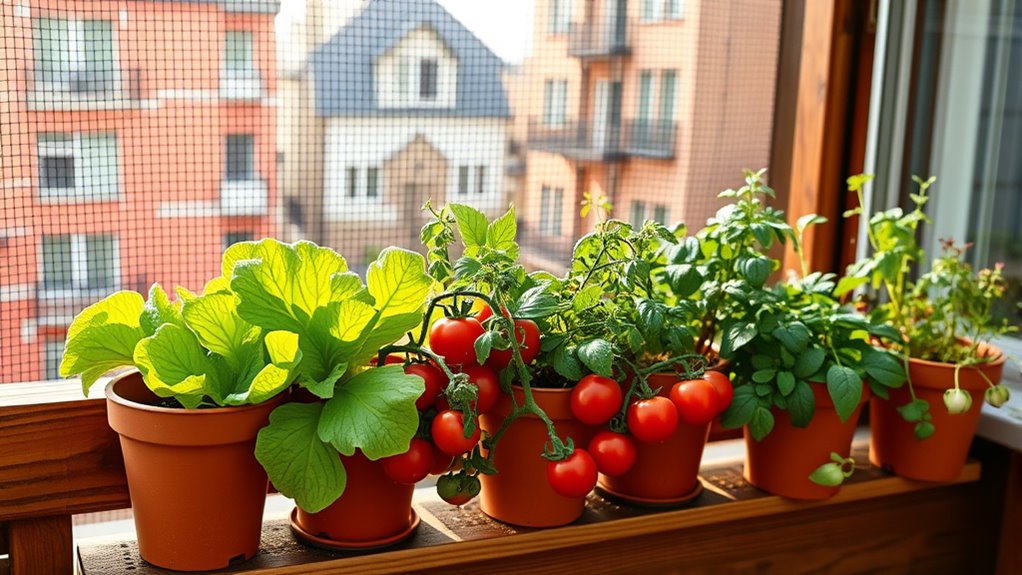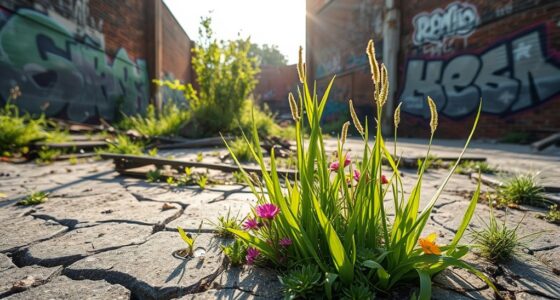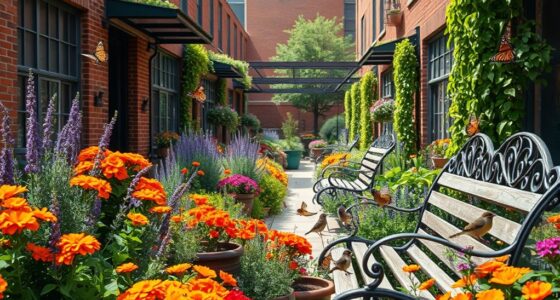Growing your own balcony veggies is a smart way to enjoy fresh produce even in small spaces. Use pots, hanging baskets, and vertical planters to maximize space and choose containers with proper drainage. Place them where they’ll get 4-6 hours of sunlight daily and water regularly to prevent drying out. Fertilize with organic feeds to encourage healthy growth. For more tips on creating a thriving balcony garden, keep exploring how to optimize every inch of your space.
Key Takeaways
- Choose compact, container-friendly vegetables like cherry tomatoes, leafy greens, and herbs for easy balcony cultivation.
- Use vertical and hanging planters to maximize limited space and increase planting area.
- Ensure containers have proper drainage and are placed where they receive 4-6 hours of sunlight daily.
- Maintain a regular watering and fertilization routine to keep plants healthy and productive.
- Regular harvesting encourages continuous growth and provides fresh, homegrown produce in small spaces.

Growing your own vegetables on a balcony is an easy and rewarding way to enjoy fresh produce without needing a backyard. With limited space, urban gardening becomes an exciting challenge, pushing you to get creative with container planting. Instead of traditional garden beds, you can transform your balcony into a lush, productive oasis by choosing the right containers and plants. The key is selecting containers that provide adequate drainage and space for roots to grow, such as pots, hanging baskets, or even stackable planters. These options allow you to maximize your small area while keeping your garden organized and accessible.
Grow fresh vegetables on your balcony with creative containers and smart planning.
When it comes to container planting, it’s important to consider the specific needs of each vegetable. For example, cherry tomatoes thrive in medium-sized pots with plenty of sunlight, while leafy greens like lettuce and spinach can grow well in smaller containers. Using high-quality potting soil designed for container gardening will give your plants the nutrients they need to flourish. Remember to place your containers where they’ll receive sufficient sunlight—at least 4 to 6 hours a day—and think about using reflective surfaces to enhance light exposure if needed.
Urban gardening on a balcony also involves managing water efficiently. Container plants tend to dry out faster than those in the ground, so regular watering is essential. Set a schedule and check soil moisture frequently. Using a drip irrigation system or self-watering pots can make maintenance easier and help prevent over- or under-watering. Fertilizing regularly with organic compost or liquid feeds will ensure your plants stay healthy and productive throughout the growing season.
Another advantage of container planting is the flexibility it offers in terms of layout and design. You can hang planters to save space or place taller containers against walls for added privacy and shade. Vertical gardening techniques, such as wall-mounted planters or tiered plant stands, maximize your balcony’s vertical space, allowing you to grow a variety of vegetables without clutter. This approach not only increases your yield but also creates a visually appealing environment.
Enjoying your balcony vegetable garden is simple when you stay attentive to your plants’ needs. Regular harvesting encourages continued production, and it’s satisfying to pick fresh peppers, herbs, or greens straight from your containers. Plus, growing your own vegetables in small spaces connects you to urban gardening traditions while reducing your carbon footprint. With a bit of planning and care, your balcony can become a thriving green space full of fresh, healthy produce, proving that even tiny outdoor areas can yield big results. Additionally, understanding offensive security measures such as ethical hacking techniques can help protect your digital assets from cyber threats.
Frequently Asked Questions
What Are the Best Vegetables for Shady Balcony Areas?
If you’re wondering about the best vegetables for shady balcony areas, focus on shade-tolerant plants like lettuce, spinach, and arugula. These thrive with limited sunlight and are perfect for container gardening tips. Make sure to choose containers that retain moisture and position them in spots that get some indirect light. By selecting the right shade-tolerant plants and following container gardening tips, you’ll enjoy fresh produce even in low-light spaces.
How Often Should I Water Balcony Veggies?
You should water your balcony veggies based on their watering frequency needs and soil moisture levels. Check the soil daily, feeling for dryness, and water when it feels dry about an inch deep. Consistency is key—avoid overwatering or underwatering—so adjust your watering frequency as the weather changes. Keep an eye on drainage, too, ensuring excess water drains away and soil stays moist but not soggy.
Which Containers Are Ideal for Small Balcony Gardens?
You should choose containers that promote good drainage and suit your space. Opt for lightweight materials like plastic or resin, which are easy to move, or consider terracotta for breathability. Make sure your containers have drainage solutions such as holes or saucers to prevent waterlogging. This helps your balcony veggies thrive by keeping roots healthy and preventing overwatering, making your small garden both functional and flourishing.
How Can I Prevent Pests on Balcony Veggies?
Imagine your balcony as a peaceful haven, free from unwelcome guests. To keep pests at bay, choose pest resistant varieties and use natural deterrents like neem oil or companion planting. Regularly inspect your plants and remove any signs of trouble early. These simple, gentle steps help protect your veggies without harsh chemicals, ensuring your small space remains vibrant, healthy, and full of fresh, delicious produce.
Are There Any Balcony-Friendly Organic Fertilization Methods?
You can use balcony-friendly organic fertilization methods by incorporating composting techniques right on your balcony. Start with small compost bins or worm bins to recycle kitchen scraps, providing rich organic amendments for your plants. These methods are eco-friendly, odor-controlled, and convenient in small spaces. Regularly add compost or organic amendments like seaweed or fish emulsion to nourish your veggies naturally, ensuring healthy, pest-resistant growth without synthetic chemicals.
Conclusion
Growing your own balcony veggies proves that big flavors don’t need big spaces. Just like a tiny window can brighten a room, a small balcony can offer a lush, fresh harvest. It’s surprising how vibrant life can be in such a compact space—proof that abundance isn’t about size, but care. So, don’t underestimate your tiny balcony; it might just become your favorite farm, right outside your door.








